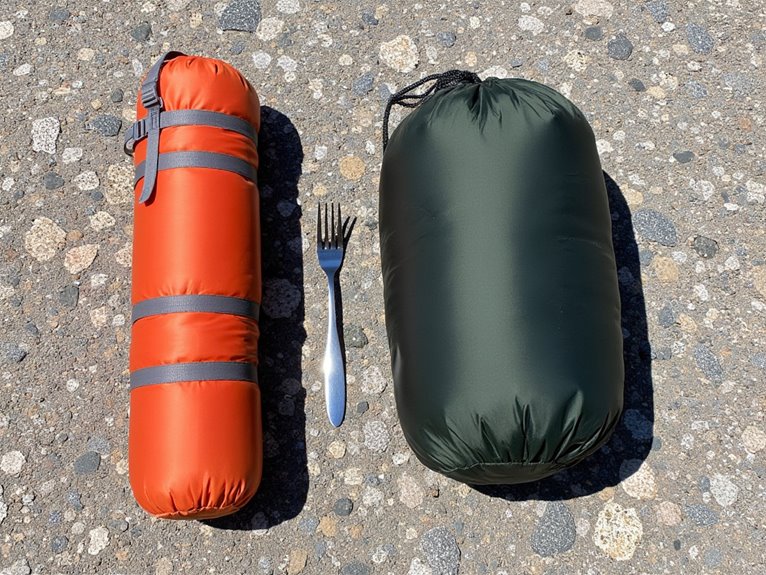How Much Harder Is Hiking With a Pack?
Hiking with a pack is approximately 10-15% more energetically costly than hiking without a load, due to increased cardiovascular strain, altered biomechanics, and increased energy expenditure. Carrying a heavy pack increases heart rate by 10-20 beats per minute, leading to fatigue, decreased endurance, and potential cardiovascular distress. Altered posture and biomechanics further reduce hiking efficiency. To compensate, hikers must adjust their pace, taking more frequent breaks and shortening stride length to conserve energy. By understanding the physical demands of hiking with a pack, you can prepare yourself for the challenge ahead and optimize your hiking strategy for success.
We are supported by our audience. When you purchase through links on our site, we may earn an affiliate commission, at no extra cost for you. Learn more. Last update on 29th December 2025 / Images from Amazon Product Advertising API.
The Weight Factor
A backpack's weight can have a profound impact on a hiker's overall experience, with even a few extra pounds capable of substantially increasing fatigue and discomfort over the course of a long hike.
This is because the added weight affects a hiker's biomechanics, forcing them to expend more energy to maintain balance and stability.
As a result, hikers may need to take more frequent breaks, reducing their overall pace and increasing the time spent on the trail.
In addition, excess weight can also lead to musculoskeletal issues, such as strained backs and shoulders, which can persist long after the hike is over.
Moreover, by minimizing pack weight, hikers can conserve energy and reduce the risk of injury, allowing them to enjoy a more comfortable and enjoyable hiking experience.
Cardiovascular Strain Increases
When hiking with a pack, the added weight substantially increases cardiovascular strain, leading to a notable spike in heart rate.
This increased cardiac workload results in a higher oxygen debt, which can have detrimental effects on overall physical performance.
As the body struggles to meet the increased oxygen demands, hikers may experience fatigue, shortness of breath, and decreased endurance.
Heart Rate Spikes Higher
During high-intensity hiking with a heavy pack, heart rate can surge dramatically, placing additional cardiovascular strain on the body.
This increase in heart rate is a response to the added weight and resistance, which requires more oxygen and energy to sustain.
As a result, the heart beats faster to pump more blood to the muscles, leading to a significant spike in heart rate.
Studies have shown that heart rate can increase by 10-20 beats per minute when carrying a heavy pack, compared to hiking without a load.
This increased cardiovascular strain can lead to fatigue, decreased endurance, and even cardiovascular distress in extreme cases.
For hikers to avoid cardiovascular exhaustion, they must be aware of their heart rate and take regular breaks.
Oxygen Debt Increases
Carrying a heavy pack while hiking increases oxygen debt, a phenomenon where the body's oxygen demand exceeds its supply, further exacerbating cardiovascular strain.
This occurs because the added weight of the pack increases the energy required for movement, which in turn increases the body's oxygen demands.
When the body's oxygen supply cannot meet this demand, oxygen debt occurs, leading to a buildup of lactic acid and increased fatigue.
As a result, hikers may experience shortness of breath, muscle cramps, and decreased endurance.
The increased cardiovascular strain can also lead to a higher risk of cardiovascular events, particularly in individuals with pre-existing heart conditions.
Energy Expenditure Multiplier
The energy expenditure multiplier, a critical component in calculating the total energy cost of hiking with a pack, represents the increased energy required to transport the added weight of a backpack.
This multiplier is typically expressed as a ratio of the energy expended while carrying a pack to the energy expended while hiking without a pack.
Studies have shown that the energy expenditure multiplier can range from 1.05 to 1.5, depending on factors such as pack weight, terrain, and individual hiking efficiency.
This means that for every unit of energy expended while hiking without a pack, an additional 5-50% of energy is required to transport the added weight of the pack.
Understanding the energy expenditure multiplier is essential for accurately evaluating the physical demands of hiking with a pack.
Altered Biomechanics and Posture
Hikers often exhibit altered biomechanics and posture when carrying a pack, which can lead to increased fatigue, discomfort, and even injury.
The added weight of the pack alters the natural gait and stride, causing hikers to adjust their posture to compensate for the load. This can result in an uneven distribution of weight, putting additional stress on the muscles and joints.
In addition, the altered biomechanics can lead to inefficient energy expenditure, reducing overall hiking efficiency. Moreover, the altered biomechanics can lead to inefficient energy expenditure, reducing overall hiking efficiency.
Crucially, hikers must be aware of these changes and take steps to maintain proper posture and biomechanics to minimize the risk of discomfort and injury.
Terrain and Elevation Challenges
When hiking with a pack, the terrain and elevation of the trail can pose significant challenges.
Steep inclines, rocky trails, and high altitude gains can all take a toll on the body, requiring hikers to adapt their technique and endurance.
Understanding these challenges is vital to traversing difficult terrain safely and efficiently.
Steep Incline Impact
Climbing steep inclines challenges even the most experienced hikers, forcing them to adapt their pace, footing, and body positioning to maintain balance and conserve energy.
The added weight of a pack amplifies the difficulty, increasing the risk of fatigue, strained muscles, and potential falls.
On steep inclines, hikers must shorten their stride, bend their knees, and lean forward to maintain traction and stability.
The pack's weight and bulk can throw off balance, making it essential to adjust posture and footwork accordingly.
Hikers should also be mindful of their route selection, choosing trails with more gradual inclines or incorporating rest breaks to alleviate the physical demands of climbing with a heavy pack.
Rocky Trail Obstacles
Beyond steep inclines, rocky trail obstacles pose a significant challenge to hikers, requiring careful negotiation of treacherous terrain and elevation changes that can be further complicated by the weight and bulk of a pack.
Rocky trails often feature uneven terrain, loose rocks, and jagged outcroppings that can trip up even the most experienced hikers.
The added weight of a pack can amplify the difficulty, making it harder to maintain balance and stability.
Hikers must be vigilant in their footing, taking smaller steps and using trekking poles if necessary to maintain traction.
It's essential to scan the trail ahead, anticipating potential hazards and adjusting pace accordingly to facilitate a safe and successful passage through rocky terrain.
Altitude Gain Struggles
Elevation changes can be particularly intimidating, as hikers must contend with reduced oxygen levels, increased fatigue, and shifting terrain that can make every step feel like a struggle.
The higher you climb, the thinner the air becomes, making it more difficult to breathe and increasing the risk of altitude sickness. This can be especially challenging when carrying a heavy pack, which can exacerbate the physical demands of hiking at high elevations.
Some key considerations when tackling altitude gain with a pack include:
- Acclimatizing to higher elevations by taking rest days and gradually increasing altitude
- Monitoring your body's response to high altitude and recognizing signs of altitude sickness
- Packing lightly and efficiently to minimize weight and maximize energy
- Building cardiovascular endurance through training and preparation to better handle the physical demands of high-altitude hiking
Pacing and Distance Adjustments
Proper pacing is essential when hiking with a pack, as it directly impacts the distance you can cover in a day and the overall success of your trip.
When carrying a heavy pack, it's vital to adjust your pace to avoid exhaustion and maintain a sustainable rhythm.
A good rule of thumb is to reduce your daily distance by 10-20% compared to hiking without a pack.
This allows for more frequent breaks, energy conservation, and reduced fatigue.
Additionally, consider shorter, more frequent steps to maintain balance and stability while carrying a heavy load.





